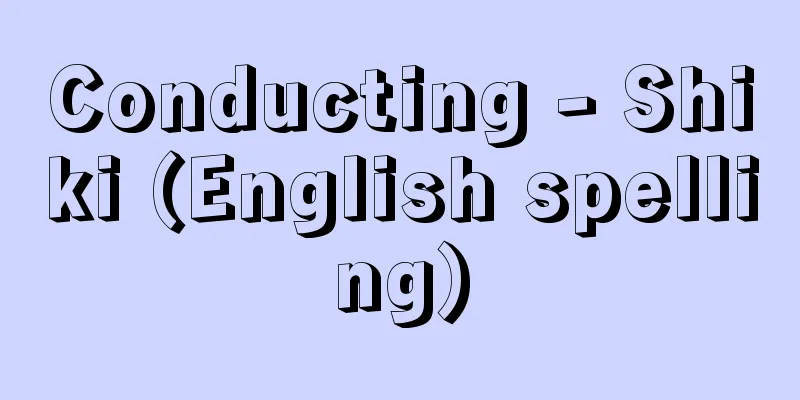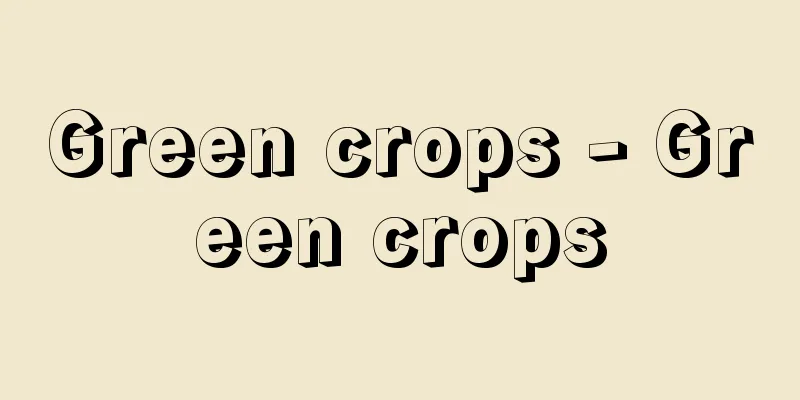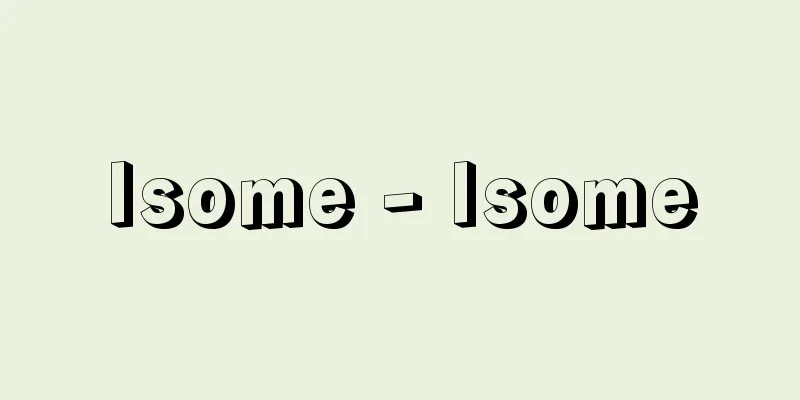Conducting - Shiki (English spelling)

|
Conducting a musical performance is an act of directing it with visible means such as gestures. The person who does this is called a conductor. Conductors, who coordinate choral and ensemble performances by multiple performers and provide a unified interpretation, were used as necessary in all musical practices, both in the West and the East. However, it was in Western music in the second half of the 19th century that conductors became independent from musical professions such as composers, instrumentalists, and vocalists, and became a special performing profession that does not produce sound themselves. The cause of this can be found in the complexity, expansion, and idealization of Western music. [Ryuichi Higuchi] History of ConductingThe prototype of conducting can already be found in the ancient civilizations of Mesopotamia, Egypt, India, and even Greece and Rome. In medieval Europe, the rise and fall of melodies in monophonic chant (so-called Gregorian chant) was indicated by hand movements (chironomy), and this pattern was inherited in early neumes. In the 15th and 16th centuries, during the Renaissance, polyphonic vocal music flourished, and in order to unify the increasingly complex choruses, conducting was carried out by indicating fixed units of time (tactus) by moving the fingers or a cane up and down. From the end of the 16th century, especially in the field of secular vocal music represented by madrigals, changes in tempo according to the mood of the lyrics became necessary. In the so-called Baroque music era of the 17th and 18th centuries, instrumental ensembles and opera flourished, and conducting also became more important. As the story of Lully, who died from a leg injury caused by his baton, shows, in addition to conducting with a baton, baton, and concertmaster's bow, conducting was also done with rolled up paper or parchment, as seen on the cover of J. G. Walter's "Dictionary of Music" (1732). In Italian opera, a double conductor was used, a concertmaster and a harpsichordist playing basso continuo, and in ensemble music it was customary for one of them to conduct, but in church music a conductor with a baton or other equipment was often needed, and triple conductors were sometimes used in addition to the first two. When the basso continuo disappeared in the 19th century, harpsichordists also stopped conducting, and many of the conductors in the early 19th century were violinists, such as Spohr and Abneg. Eventually, they also began to conduct with bows and batons, and in the era of Spontini, Weber, and Mendelssohn, the baton became mainstream. Wagner and Berlioz laid the foundations for modern conducting. In particular, Wagner trained two of the greatest conductors of the second half of the 19th century, Hans von Bülow and Hans Richter, under his students. These two are the ancestors of professional conductors in the modern sense. Following them were Nikisch, R. Strauss, Mahler, Furtwängler, Beecham, Walter, and Klemperer, and the German and Austrian tradition represented by the modern Boehm and Karajan was formed. There is the French tradition of Monteux and Munch, and the Italian tradition of Toscanini, but in modern times there has been a stronger international focus, as shown by the presence of America's Bernstein, Japan's Seiji Ozawa, and India's Zubin Mehta. [Ryuichi Higuchi] ConductingConducting is based on the conductor's overall musical expression, but modern conducting theory has made it possible to express all musical elements, except pitch, such as rhythm, tempo, dynamics, and expression, through the movement of both hands. The functions of both hands are differentiated. Whether or not the conductor is holding a baton, the right hand has the main function. Meter structures such as duple, triple, and quadruple are expressed by drawing specific shapes with the right hand. The size of the shape indicates the volume, the speed of the beats indicates the tempo, and the strength of each beat expresses the change in rhythm. There are basically three types of metronomes: duple, triple (triangle), and quadruple. By combining and changing these, 5, 6, 7, 8, and 12 beats can be expressed, and when the tempo is slow, each beat of the shape is divided for clarity. The left hand mainly has an auxiliary function. These include the temporary emphasis of each function of the right hand, expression, restraint and demand, and instructions for when each player should begin playing (start playing, start singing, start playing). A conductor who has mastered these basic conducting techniques will first analyze the score, understand the composer's musical concept, discover his own interpretation in relation to his own musicality, and then carefully consider and prepare the application of conducting techniques appropriate to each part as a means of expression. The practice session (rehearsal) that follows is a place of co-creation between the conductor and the orchestra members (choir members), and the concert in front of an audience should ideally be a place for a musical experience that is further enhanced by the mental exchange between the conductor, performers, and audience. [Ryuichi Higuchi] "An introduction to conducting" by Saito Hideo (1956, Ongaku No Tomo Sha)" ▽ "The techniques of conducting" by Yamada Kazuo (1966, Ongaku No Tomo Sha)" ▽ "Conducting" by M. Rudolph, translated by Otsuka Akira (1968, Ongaku No Tomo Sha)" ▽ "Textbook of choral conducting, all 3 volumes by K. Thomas, translated by Itoga Hidenori and Amano Shokichi (1965-66, Ongaku No Tomo Sha)" ▽ "Introduction to conducting" by Takashina Masamitsu (1979, Ongaku No Tomo Sha)" ▽ "Great Conductors: History and genealogy of conducting" by H.C. Schonberg, translated by Nakamura Kosuke (1980, Ongaku No Tomo Sha) ©Shogakukan "> Example of how to wave a baton Source: Shogakukan Encyclopedia Nipponica About Encyclopedia Nipponica Information | Legend |
|
音楽演奏を身ぶり手ぶりなどの可視的手段で統率する行為。それを行う者を指揮者という。複数の演奏者による合唱、合奏を整え、解釈の統一を与えるための指揮者は、西洋・東洋を問わず、あらゆる音楽実践に必要に応じて用いられたが、それが作曲家、器楽演奏家、声楽家などの音楽的職業から分化し、自らは音を発さない特殊な演奏的職業として独立したのは、19世紀後半の西洋音楽においてであった。西洋音楽の複雑化、肥大化、理念化にその原因が求められる。 [樋口隆一] 指揮の歴史指揮の原型は、すでにメソポタミア、エジプト、インド、さらにギリシア、ローマの古代文明にみいだされる。中世ヨーロッパでは単旋律聖歌(いわゆるグレゴリオ聖歌)の旋律の上下を手の運動(カイロノミー)で示したが、この図型は初期のネウマ譜に受け継がれた。15、16世紀、ルネサンスの時代にはポリフォニー声楽曲が隆盛を迎えたが、複雑化する合唱の統一のため、一定の時間単位(タクトゥス)を指または杖(つえ)の上下で示す指揮が行われた。16世紀末から、とくにマドリガーレに代表される世俗的声楽曲の分野では、歌詞の情調に応じたテンポの変化が求められるようになった。17、18世紀のいわゆるバロック音楽の時代には、器楽合奏とオペラの隆盛がみられ、指揮の重要性も増した。指揮杖による足のけがが原因で世を去ったリュリの故事が示すように、指揮杖、指揮棒、コンサートマスターの弓による指揮のほか、J・G・ワルターの『音楽辞典』(1732)の表紙にみられるように、丸めた紙や羊皮紙による指揮も行われた。イタリア・オペラでは、コンサートマスターと通奏低音のチェンバロ奏者による二重指揮が行われ、合奏音楽ではそのどちらかによる指揮が通例であったが、教会音楽では指揮棒などを持った指揮者が必要なことも多く、前二者とともに三重指揮をとることもあった。 19世紀に入り通奏低音が姿を消すと、チェンバロ奏者による指揮も行われなくなり、19世紀初めの指揮者には、シュポーア、アブネックのようなバイオリン奏者が多い。やがて彼らも弓や棒で指揮するようになり、スポンティーニ、ウェーバー、メンデルスゾーンの時代では指揮棒が主流となった。近代の指揮法の基礎をつくったのはワーグナーとベルリオーズである。とくにワーグナーは、その門下にハンス・フォン・ビューローとハンス・リヒターという19世紀後半を飾る二大指揮者を育てた。この2人が、現代的な意味での職業指揮者の祖である。その後に続く、ニキシュ、R・シュトラウス、マーラー、さらにフルトウェングラー、ビーチャム、ワルター、クレンペラーを経て、現代のベーム、カラヤンに代表されるドイツ、オーストリア系列の伝統が形成された。モントゥーやミュンシュによるフランスの伝統、トスカニーニによるイタリアの伝統もあるが、現代はアメリカのバーンスタイン、日本の小沢征爾(せいじ)、インドのズビン・メータの存在が示すように、国際性が強くなった。 [樋口隆一] 指揮法指揮はもとより指揮者の全人格的な音楽表現を基礎とするが、現代の指揮理論は、リズム、テンポ、強弱、表情など、音高を除いたあらゆる音楽の要素を、両手の運動によって示すことを可能とした。両手の機能は分化している。指揮棒を持つか否かにかかわらず、おもな機能は右手が有している。2拍子、3拍子、4拍子などの拍節構造は、それぞれに定められた図形を右手で描くことによって示される。図形の大小で音量が、打拍の速度によりテンポが示され、各打拍の強弱によりリズムの変化が表現される。基本的には2拍子、3拍子(三角形)、4拍子の3種類で、それらの組合せと変化により、5拍子、6拍子、7拍子、8拍子、12拍子が表現されるほか、ゆっくりしたテンポのときには、明瞭(めいりょう)化のために図形の各拍の分割が行われる。左手は主として補助的な機能をもっている。右手の各機能の一時的強調、表情づけ、抑制と要求、各奏者の弾き始め(吹き始め、歌い始め、アインザッツ)の指示などである。こうした基礎的な指揮法を修得した指揮者は、まず総譜の分析を行い、作曲家の音楽的構想を理解し、自己の音楽性との対応のなかから自己の解釈を発見し、その表現の手段として、各部分に即した指揮法の応用を熟慮し、準備を整える。そのあとに迎える練習(リハーサル)は指揮者と楽団員(合唱団員)との共同創造の場であり、聴衆の前での演奏会は、指揮者、演奏家、聴衆の三者の心的交流によってさらに高められた音楽体験の場となることが理想である。 [樋口隆一] 『斎藤秀雄著『指揮法教程』(1956・音楽之友社)』▽『山田一雄著『指揮の技法』(1966・音楽之友社)』▽『M・ルードルフ著、大塚明訳『指揮法』(1968・音楽之友社)』▽『K・トーマス著、糸賀英憲・天野晶吉訳『合唱指揮教本』全3巻(1965~66・音楽之友社)』▽『高階正光著『指揮法入門』(1979・音楽之友社)』▽『H・C・ショーンバーグ著、中村洪介訳『偉大な指揮者たち――指揮の歴史と系譜』(1980・音楽之友社)』 ©Shogakukan"> 指揮棒の振り方の例 出典 小学館 日本大百科全書(ニッポニカ)日本大百科全書(ニッポニカ)について 情報 | 凡例 |
Recommend
Pearl Danio (English)
...Because their mouths are small, there is no pr...
Houseido Kisanji - Houseido Kisanji
Year of death: Bunka 10.5.20 (1813.6.18) Year of b...
Eitai Kosaku - Eitai Kosaku
" Eikosaku English: " Same as " Sou...
The Kyoto Gathering Incident
…On March 1, 1906, the three Tokyo City Railways,...
mu'adhdhin (English spelling) muadhdhin
…The adhan is a practice (sunna) in Islamic law, ...
Oinone - Oinone
…At his birth, he was abandoned in Mount Ida beca...
Buontalenti, B. (English spelling) BuontalentiB
…Art museum in Florence, Italy. Construction of t...
Stone circle
A type of megalithic monument. It is translated as...
Aiko
…If (B) puts out two fingers and calls it 4, then...
Error correcting code
Data added to detect and correct errors that occur...
Seiche
…When a large earthquake occurs, the water in a l...
Forced vote - Kyoukou saiketsu
A spontaneous vote conducted by the chairman or sp...
Shinetsu Main Line - Shinetsu Main Line
The name of the East Japan Railway Company (JR Ea...
Einsatz
...Generally, the conductor directs an orchestra,...
Cyperus cyperoides (English spelling) Cyperuscyperoides
...Himekugu is distributed throughout Japan and C...









